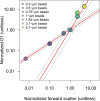SeaFlow data v1, high-resolution abundance, size and biomass of small phytoplankton in the North Pacific
- PMID: 31757971
- PMCID: PMC6874581
- DOI: 10.1038/s41597-019-0292-2
SeaFlow data v1, high-resolution abundance, size and biomass of small phytoplankton in the North Pacific
Abstract
SeaFlow is an underway flow cytometer that provides continuous shipboard observations of the abundance and optical properties of small phytoplankton (<5 μm in equivalent spherical diameter, ESD). Here we present data sets consisting of SeaFlow-based cell abundance, forward light scatter, and pigment fluorescence of individual cells, as well as derived estimates of ESD and cellular carbon content of picophytoplankton, which includes the cyanobacteria Prochlorococcus, Synechococcus and small-sized Crocosphaera (<5 μm ESD), and picophytoplankton and nanophytoplankton (2-5 μm ESD). Data were collected in surface waters (≈5 m depth) from 27 oceanographic cruises carried out in the Northeast Pacific Ocean between 2010 and 2018. Thirteen cruises provide high spatial resolution (≈1 km) measurements across 32,500 km of the Northeast Pacific Ocean and 14 near-monthly cruises beginning in 2015 provide seasonal distributions at the long-term sampling site (Station ALOHA) of the Hawaii Ocean Time-Series. These data sets expand our knowledge of the current spatial and temporal distributions of picophytoplankton in the surface ocean.
Conflict of interest statement
The authors declare no competing interests.
Figures





References
-
- Finkel ZV, et al. Phytoplankton in a changing world: cell size and elemental stoichiometry. Journal of Plankton Research. 2010;32:119–137. doi: 10.1093/plankt/fbp098. - DOI
-
- Raven JA. The twelfth Tansley Lecture. Small is beautiful: the picophytoplankton. Functional Ecology. 1998;12:503–513. doi: 10.1046/j.1365-2435.1998.00233.x. - DOI
-
- Bonnet S, Biegala IC, Dutrieux P, Slemons LO, Capone DG. Nitrogen fixation in the western equatorial Pacific: Rates, diazotrophic cyanobacterial size class distribution, and biogeochemical significance. Global Biogeochemical Cycles. 2009;23:1–13. doi: 10.1029/2008GB003439. - DOI
Publication types
MeSH terms
Substances
Grants and funding
LinkOut - more resources
Full Text Sources
Miscellaneous

